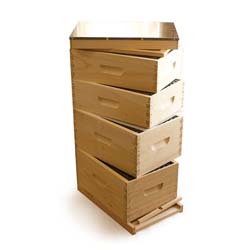Once detected, most honeybee colonies cannot survive without some form of intervention to reduce Varroa mites. Varroa mites are a relatively new threat to European honeybees so they haven’t had the time to build up much of a defense. To develop better varroa resistant behaviors, colonies need time to promote those behaviors through generations of queens. Each queen bee will pass on different genetics, allowing certain traits to strengthen over time. Certain strains of honeybees are more naturally resistant to varroa mites. Some varieties are more hygienic, leading to more grooming, in turn lowering mite numbers. It is becoming increasingly popular to search for these more resistant strains of bee, such as Russian bees.
Varroa mites can often work in a feedback loop: weak colonies are hit hard by varroa, meaning they are losing energy/unable to keep up with their stores, but they need the food to grow strong to defend themselves against varroa. A colony can defend against low mite numbers, but once those populations start increasing, they are fighting against both the mite and the diseases they carry.
Some beekeepers have been successful in breeding their own Varroa-resistant stock of bees, however this takes a lot of active management, experimenting, and work. If this is something you are interested in doing, please do your research and investigate any local beekeepers who might be doing this.
Honeybees can take care of Varroa mites themselves to a certain extent, but once Varroa mites gain enough of a population, they will wreak havoc on honeybee colonies until they are run into the ground. Any form of intervention (prevention, mechanical, or chemical) will help ensure the survivability of your colonies.
